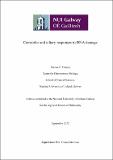| dc.description.abstract | Centrosome duplication is tightly controlled and takes place only once every cell cycle. In recent years more light has been shed on the mechanism of centrosome duplication, with key players being identified and characterised. We sought to characterise Stil, a gene mutated in autosomal recessive microcephaly and which encodes a centrosomal protein. We found that Stil localises to the centrosome in chicken DT40 and that it is evolutionarily conserved between chicken and mammals. We were unable to generate a Stil knockout cell line in DT40 and concluded that Stil is essential for viability and that precise expression levels are critical for viability.
Various centrosome abnormalities are observed in cancer cells and in cells with defective DNA damage responses. Moreover, centrosome abnormalities can arise following DNA damage. In this study, we aimed to characterise the impact of irradiation-induced DNA damage on the structure of the centrosome. We found that irradiation leads to the isolation of single centrioles, termed centriole splitting, and that this precedes DNA damage-induced centrosome amplification. We observed that DNA damage causes centriole splitting in non-transformed human cells, with the isolated centrioles carrying the mother markers Ninein and CEP170 but not Cenexin or Kizuna. Loss of centrosome cohesion through siRNA depletion of C-NAP1 or Rootletin increased radiation-induced centriole splitting, with C-NAP1-depleted isolated centrioles losing all maturation markers.
Primary cilia are sensory organelles which receive chemical and mechanical signals from the extracellular environment. Defects in primary cilia structure and signalling cause human diseases termed ciliopathies and cancer. As the mother centriole forms the primary cilium, we tested whether DNA damage or centriole splitting affected ciliogenesis. We found that irradiated cells formed apparently normal primary cilia, which arose primarily from centriole clusters and not isolated centrioles. Additionally, multiple primary cilia can form in irradiated cells. Furthermore, C-NAP1 or Rootletin knockdown reduced primary cilium formation. Therefore, the centrosome cohesion apparatus at the proximal end of centrioles may provide a target that can affect primary cilium formation as part of the DNA damage response. | en_US |


